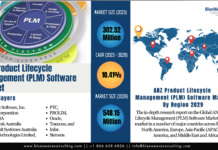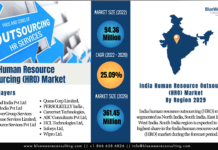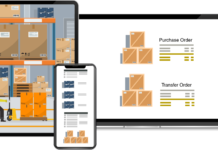Electronic Design Automation Software Market is flourishing owing to the increased importance of EDA in electrical design processes, advancements in system-on-chip (SoC) technology, and increased adoption of modern technologies such as the internet of things and artificial intelligence.
A recent study conducted by the strategic consulting and market research firm, BlueWeave Consulting, revealed that the Global Electronic Design Automation Software Market was worth USD 9.87 billion in the year 2021. The market is projected to grow at a CAGR of 10.1%, earning revenues of around USD 19.16 billion by the end of 2028. The increasing use of FinFET architecture in the design of advanced processors is a major factor driving the growth of the electronic design automation software market. The increased adoption of AI, IoT, and VR, as well as the rise in SoC technology, are all contributing to the massive demand for this software. However, the availability of open-source EDA software is expected to stymie the growth of the EDA software market. During the forecast period, the rising demand for smaller electronic devices, as well as the increasing penetration of AI and machine learning in EDA, are expected to provide profitable opportunities for electronic design automation software market players.
Increasing Adoption of Connected Devices
Over the last few years, the use of connected devices such as smartphones, wearables, and smart home systems has increased dramatically. The incorporation of power electronics into these devices is expected to drive the global electronic design automation market forward. The growing demand for high performance with low power consumption capability is expected to fuel future demand for electronic design automation solutions, influencing industry participants to make developments in their IP cores. The number of IoT-connected devices is expected to reach 50 billion by 2025. The majority of devices would not be traditional PCs or smartphones, but rather a growing web of interconnected devices that would include home appliances, security systems, and other devices.

Sample Report @ https://www.blueweaveconsulting.com/report/electronic-design-automation-software-market/report-sample
Cloud-based Services are Becoming More Popular
The processing, power, and infrastructure required for designing, testing, validating, and building electronic systems have increased significantly as they have become more sophisticated. CAE and electronic design automation have fueled the demand for massive scale computation and data management in next-generation electronic devices. Because verifying components take up a large portion of the overall design time in these systems, electronic design automation companies have made significant investments in large server farms and high-performance storage systems to enable excellent quality and fast turnaround of semiconductor tests and validation. Cloud-based services are now used by semiconductor companies to benefit from the quick and flexible deployment of electronic design automation infrastructure.
Challenges: Continuous Technological Advancements
Particularly in the semiconductor sector, technology is a concept that is constantly evolving. New technologies would enter the market and upset the balance with each leap. The same is true for the IC sector, where process nodes are crucial. Design complexity, chip form factor, and IP core design architecture are all affected by changes in a semiconductor chip’s nodes. Therefore, technical difficulties with device integration and the creation of a new design methodology are some of the difficulties in SoC designing. The sizes of technology nodes are constantly changing as a result of evolution. Therefore, the IP core design architecture must be changed by semiconductor chip manufacturers. The majority of businesses have been improving their electronic design automation solutions to meet consumer demand.
Segmental Coverage
Global Electronic Design Automation Software Market – By Application
Global Electronic Design Automation Software Market is classified into the following applications: automotive, healthcare, defense & aerospace, industrial, communication, consumer electronics, and others. In terms of application, the consumer electronics industry accounted for the largest revenue share for electronic design automation software in 2020. This is due to the constant advancement of consumer electronics such as smartphones, tablets, laptops, desktop computers, and cameras. It is also expected that EDA software will fill a gap in the market for models, methods, and tools. During the forecast period, all of these factors will drive the growth of the Global Electronic Design Automation Software Market (2022-2028).
Impact of COVID-19 on Global Electronic Design Automation Software Market
The COVID-19 pandemic is expected to have a significant impact on the development of the market for electronic design automation software. Spending in the electronic design automation industry is expected to fall when compared to pre-pandemic levels. It is caused by several factors, including a decline in semiconductor industry revenue in 2020. The slow rate of production and scarcity of raw materials harm market growth. Several factories in several countries have been forced to close due to the pandemic. A large number of semiconductor organizations, on the other hand, are urging the government to classify the semiconductor industry as critical. They will be able to continue operations, ensuring that customer demand is met and industry supply is maintained.
Competitive Landscape
The leading market players in the Global Electronic Design Automation Software Market are Cadence Design Systems, Inc., Synopsys, Inc., Siemens, ANSYS, Inc., Keysight Technologies, Inc., Xilinx, Inc., eInfochips, Altium Limited, Zuken Inc., Silvaco, Inc., Altair, Aldec, Inc., Autodesk, Vennsa Technologies, Boldport Limited, and other prominent players. The Global Electronic Design Automation Software Market is highly fragmented with the presence of several manufacturing companies in the country. The market leaders retain their supremacy by spending on research and development, incorporating cutting-edge technology into their goods, and releasing upgraded items for customers. Various tactics, including strategic alliances, agreements, mergers, and partnerships, are used.
The in-depth analysis of the report provides information about growth potential, upcoming trends, and statistics of the Global Electronic Design Automation Software Market. It also highlights the factors driving forecasts of total market size. The report promises to provide recent technology trends in the Global Electronic Design Automation Software Market and industry insights to help decision-makers make sound strategic decisions. Furthermore, the report also analyzes the growth drivers, challenges, and competitive dynamics of the market.
Contact Us:
BlueWeave Research Blog
Phone No: +1 866 658 6826
Email: info@blueweaveconsulting.com














